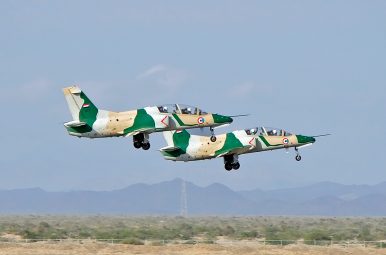By Shakil Bin Mushtaq
 A new contract has been signed that will see China deliver 23 units of Hongdu K-8W intermediate training jets to the Bangladesh Air Force (BAF). The deal was sealed on June 20 at the Bangladesh Air Force Headquarters in Dhaka. Bangladesh’s newly appointed Air Force chief was present at the signing ceremony along with China’s ambassador in Bangladesh. BAF did not disclose the total amount of the deal, but a source told The Diplomat that it’s more than $200 million.
A new contract has been signed that will see China deliver 23 units of Hongdu K-8W intermediate training jets to the Bangladesh Air Force (BAF). The deal was sealed on June 20 at the Bangladesh Air Force Headquarters in Dhaka. Bangladesh’s newly appointed Air Force chief was present at the signing ceremony along with China’s ambassador in Bangladesh. BAF did not disclose the total amount of the deal, but a source told The Diplomat that it’s more than $200 million.
The light attack-cum-jet trainer is now being used by the People’s Liberation Army Air Force (as its domestic variant, the JL-8), Pakistan Air Force, Egyptian Air Force, Myanmar Air Force, and Bangladesh Air Force, among others.
This deal marks the second phase of Bangladesh’s K-8W fleet. Bangladesh has been using this aircraft since September 2014, when the first batch of four units of K-8Ws was inducted into the service. BAF sources say that the K-8Ws will be replacing the aged Cessna T-37s fleet. There are also plans to buy 16 units of the Russian Yak-130 to replace the T-37.
Why the K-8W? In 2010, Myanmar purchased 50 units of the K-8W, which put the BAF under pressure to also buy more training jets to advance its capability and quantity. The K-8W will prepare pilots to operate the service frontline fleet of China-made Chengdu and Mig-29 fighters.
In addition, the K-8W and another training aircraft of the BAF, the Aero L39 Albatros developed by the former Czechoslovakia, use the same engine. The Ivchenko Al-25 is a widely used twin-shaft medium bypass turbofan engine developed by the former Soviet Union. The BAF will be seriously considering maintainability and spare part issues based on its budget.
Meanwhile, there is some side talk in different defense blog sites that the BAF may be making a mistake by buying more training aircraft instead of developing a good fighter inventory. A source in the BAF, when asked about that argument, said that the K-8W deal was part of the country’s Forces Goal 2030 – even if the details pertaining to that part of the plan haven’t been publicized. At the moment BAF needs to build a decent number of jet trainers, he argued, and more attack fighters are coming soon. He also mentioned that a squadron of multirole jet fighters will be visible shortly, but the model and country of origin is still classified.
The criticism started as Bangladesh currently has fewer than 45 fighter jets but has 51 jet training aircraft. The new fleet of K-8Ws will increase the number of trainers. However, the BAF source said that a large number of old training jets will be retired soon, so this procurement is no “fun” but a very “timely need.”
According to the publicly available data of Forces Goal 2030, the BAF will set up an advance fighter pilot training unit named “105 Advance Jet Training Unit.” The unit will consist of three training squadrons, which will provide advanced training to the pilots selected for operating fighter jets.
Overall, Forces Goal 2030 plans to make the Bangladesh Air Force a technologically advanced, well-trained, and well-equipped force that can deter any threat to Bangladeshi airspace. These plans emphasize strengthening both air power and air defense capabilities. To efficiently perform the increasing duties and responsibilities, the air force is being divided into two separate commands, “Southern Air Command” and “Northern Air Command.” Two new airbases have been already set up — one at Cox’s Bazar and Bangabandhu airbase at Dhaka, with plans to modernize and expand the Cox’s Bazar air base. A new air base and a maritime air support operation center (MASOC) are being set up under Southern Air Command at Barisal to ensure maritime security. Another air base is under construction at Sylhet.
Shakil Bin Mushtaq is a Bangladesh born journalist and author.
No comments:
Post a Comment